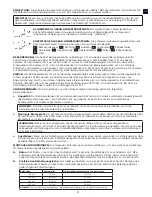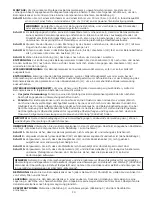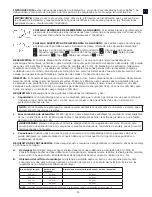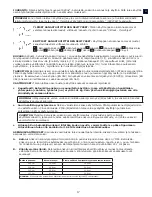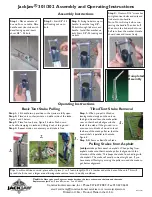
4
INSTALLATION:
To ensure effective installation of the Concrete Wedge Anchor, always observe the
Installation
Requirements
defined in the previous section. Perform the following steps to install the Concrete Wedge Anchor.
Refer to Figure 1 for component identification:
Step 1.
Drill a 7.62 cm (3 in.) or deeper hole at the desired mounting location with a Rotary Hammer and
industrial grade 20 mm (or 3/4 in.) Rotary Hammer Drill Bit.
WARNING:
Before drilling holes, inspect the hole location to prevent drilling into power transmission
cables or other live utilities.
Step 2.
The mounting hole must be free of debris for the Concrete Wedge Anchor to develop maximum
anchorage. Blow all debris out of the hole with a Blow-Out Bulb or Compressed Air. If you are reusing an
existing hole, inspect thoroughly for debris and a uniform surface.
Step 3.
Place your thumb in the anchor Swivel Ring (1A) and pull up on the Trigger (1C) with two fingers until
fully retracted.
Step 4.
Insert the anchor into the mounting hole until the Release Plug (1D) seats against the concrete surface
and then release the Trigger (1C).
Step 5.
Pull up on the anchor Swivel Ring (1A) to set the anchor.
REMOVAL:
To release the Concrete Wedge Anchor, push down on the Release Plug (1D) and pull up on the
Trigger (1C). If the anchor does not release, tap the Release Plug (1D) and repeat the process.
REUSE:
The Concrete Wedge Anchor may be reused if it has not been subjected to a fall force.
DISPOSAL:
Dispose of the Concrete Wedge Anchor if it has been subjected to fall force or
Inspection
reveals an
unsafe or defective condition. Before disposing of the Concrete Wedge Anchor, cut the Wedges off the Retractor
Cables (1J) to eliminate the possibility of inadvertent reuse.
INSPECTION FREQUENCY:
To ensure safe, efficient operation, the Concrete Wedge Anchor should be inspected
at the following intervals:
•
Before Each Use:
Visually inspect the Concrete Wedge Anchor per the
Inspection
steps defined in the next
section.
•
Annually:
A formal inspection of the Concrete Wedge Anchor and its connection to the structure
must be performed at least annually by a competent person other than the user. The frequency
of formal inspections should be based on conditions of use or exposure. See the next section for
Inspection
steps. Record the inspection results in the
Periodic Examination and Repair History
in the
“General Instructions for Use and Maintenance” (5902392)
.
IMPORTANT:
Extreme working conditions (harsh environment, prolonged use, etc.) may require increasing the
frequency of inspections.
INSPECTION:
Per the intervals defined in in the previous section, inspect the Concrete Wedge Anchor as follows.
(Refer to Figure 1 for component identification):
Step 1.
Make sure the Concrete Wedge Anchor is straight and is operating smoothly.
Step 2.
Make sure the Label (1B) is attached to the Concrete Anchor and is legible (see Figure 2).
Step 3.
Make sure the Main Cable (1G) and Retractor Cables (1J) are not kinked, frayed, or damaged.
Step 4.
Make sure metal components are not damaged or excessively corroded.
Step 5.
Make sure the Wedges (1F) and Retractor Cables (1J) operate smoothly and no metal burrs are present.
Ensure Wedges (1F) do not exhibit any deformities.
NOTE:
Record the inspection date and results in the Periodic Examination and Repair History in the “General
Instructions for Use and Maintenance” (5902392). If inspection reveals a defect, remove the anchor form
service and dispose in the mannner indicated in the “Disposal” section.
CLEANING:
After each use, blow off the Concrete Wedge Anchor with compressed air. Keep the anchor free of
grease, oils, and dirt.
STORAGE:
Store the Concrete Wedge Anchor in a clean dry environment. Avoid areas where chemical vapors
may exist. Do not pile objects on top of the anchor. Thoroughly inspect the Concrete Wedge Anchor after extended
storage.
SPECIFICATIONS:
See the front cover for materials (Figure 1) and physical dimensions (Figure 3).









